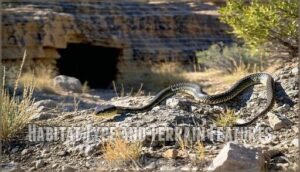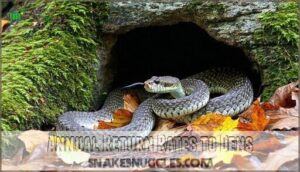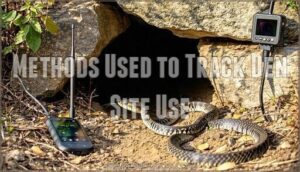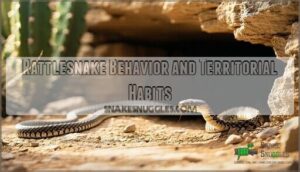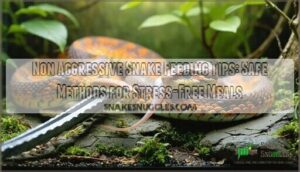This site is supported by our readers. We may earn a commission, at no cost to you, if you purchase through links.
 You’ll discover that rattlesnakes typically travel 1-2 miles from their winter dens during active months, though it’s not a straight shot.
You’ll discover that rattlesnakes typically travel 1-2 miles from their winter dens during active months, though it’s not a straight shot.
Most species stick within this range, making daily movements of just 50-200 meters as they hunt and patrol their territory. Prairie rattlesnakes are the wanderers of the bunch, sometimes venturing 2-4 miles from home base.
The real eye-opener? Some documented migrations have reached 25 kilometers – that’s over 15 miles! But don’t panic; these marathon journeys are rare exceptions, not the norm.
Most rattlesnakes are homebodies who return faithfully to their cozy dens each winter. What actually drives them to pack up and explore new territory might surprise you, and understanding this can be a key to appreciating their behavior.
Table Of Contents
- Key Takeaways
- How Far Do Rattlesnakes Travel From Their Den?
- Factors Influencing Rattlesnake Travel Range
- Rattlesnake Den Locations and Site Fidelity
- Rattlesnake Behavior and Territorial Habits
- Safety Tips for Avoiding Rattlesnake Encounters
- Frequently Asked Questions (FAQs)
- Do rattlesnakes stay in the same area?
- How big is a rattlesnakes territory?
- Do rattlesnakes return to the same den?
- How to find a rattlesnake den in the ground?
- What factors influence rattlesnakes travel distances?
- How do rattlesnake travel patterns affect ecosystems?
- Can climate change impact rattlesnake travel behaviors?
- Do rattlesnakes follow specific routes when traveling?
- How do human activities affect rattlesnake travel?
- Do rattlesnakes ever permanently relocate dens?
- Conclusion
Key Takeaways
- You’ll find that rattlesnakes typically travel 1-2 miles from their winter dens during active months, though prairie rattlesnakes can venture up to 4 miles and some exceptional individuals reach distances over 15 miles.
- Your daily encounters with rattlesnakes occur within just 50-200 meters of their current location, as they make short hunting trips rather than long-distance travels on any given day.
- You can expect that over 80% of rattlesnakes will return faithfully to the same den each winter, making their presence somewhat predictable if you know where their hibernation sites are located.
- You should take precautions within a 2-mile radius of known denning areas, especially during late spring and early summer when males travel farthest seeking mates and activity peaks.
How Far Do Rattlesnakes Travel From Their Den?
You’ll be surprised to learn that rattlesnakes can travel up to four miles from their winter dens, though most stick closer to home.
Adult rattlesnakes typically roam one to two miles during active months, while their daily movements usually cover just 50 to 200 meters as they hunt for rodents and seek shelter.
Typical Travel Distance by Species
Rattlesnake travel patterns vary dramatically across species, making species comparison essential for understanding their hunting range and behavior.
Size matters when determining how far these serpents venture from their dens, with geographic variance playing a vital role in their movements.
- Western Diamondback: Travel 1-2 kilometers seasonally, with daily movement under 500 meters
- Eastern Diamondback: Average 900 meters seasonal range, maximum 2.5 kilometers documented
- Timber Rattlesnake: Typical 1-2 kilometer range, some reaching 4 kilometers from dens
- Prairie Rattlesnake: Largest range at 1.5-4 kilometers, with GPS tracking showing 6+ kilometer travels
Maximum Documented Migration Range
Record-breaking long-distance migrants showcase rattlesnakes’ surprising travel capabilities, with some individuals pushing far beyond typical ranges.
These remarkable travelers can venture up to 25 kilometers from home, defying expectations about snake mobility
Prairie rattlesnakes hold the crown, reaching up to 25 kilometers from dens, while timber rattlesnakes max out around 7.2 kilometers in Appalachian studies.
Timber rattlesnakes often use rocky crevices for denning.
| Species | Maximum Distance |
|---|---|
| Prairie Rattlesnake | 25 km (15.5 miles) |
| Timber Rattlesnake | 7.2 km (4.5 miles) |
| Western Rattlesnake | 10 km (6 miles) |
| Eastern Massasauga | 3.2 km (2 miles) |
These extreme dispersal events represent rare individual variation rather than normal behavior, and are a key aspect of understanding rattlesnake migration patterns and their travel capabilities.
Daily Vs. Seasonal Movement Patterns
Daily movement tells a different story than you might expect.
Your typical rattlesnake covers just 50 to 200 meters per day, basically shuffling around like they’re window shopping.
However, seasonal migration patterns reveal their true wanderlust, with some traveling up to four miles from their winter dens during active months.
Activity peaks occur during late spring and early summer, showcasing their true wanderlust.
Juvenile Vs. Adult Dispersal Distances
When you compare baby rattlesnakes to their parents, you’ll notice striking differences in Natal Den Proximity and movement patterns.
Juvenile rattlesnakes stick close to home, rarely wandering more than 500 meters from their birthplace, while adults explore territories spanning multiple kilometers.
This Juvenile Vulnerability drives cautious behavior, as Dispersal Mortality Rates climb sharply with distance from safety.
Factors Influencing Rattlesnake Travel Range
You’ll discover that rattlesnakes don’t just randomly wander from their dens – several key factors determine exactly how far they’re willing to travel.
The availability of food, water, suitable terrain, seasonal weather changes, and human interference all play vital roles in shaping their movement patterns throughout the active season.
Habitat Type and Terrain Features
Rocky terrain shapes your rattlesnake’s wandering habits dramatically.
Den microclimates in national forest ecology create thermal refuges, while terrain complexity offers hunting corridors through vegetation cover.
Snake habitat loss forces longer journeys between suitable spots.
Steep elevation gradients limit movement, keeping snakes closer to den sites.
Open areas? They’ll sprint across faster than through dense brush, making snake habitats essential for understanding rattlesnake behavior patterns.
Availability of Prey and Water Sources
You’ll find that prey abundance directly shapes how far rattlesnakes venture from their Snake Dens.
When rodent populations thrive nearby, these snakes maintain smaller Foraging Ranges, staying closer to home base.
However, Water Scarcity and declining Prey Abundance force rattlesnakes to expand their hunting territories substantially, sometimes doubling their typical travel distance for better Hunting Success and Diet Variation opportunities.
The availability of prey can be substantially impacted by large herbivores presence.
Climate and Seasonal Changes
Temperature changes dramatically affect how far you’ll find rattlesnakes from their snake dens.
During Hibernation Emergence in spring, these serpents begin their Changing Migration patterns as warming soil triggers Seasonal Activity.
Climate Impact drives rattlesnakes to venture farther during peak summer months, while cooler fall temperatures signal their return journey.
Range Shifts occur when unusual weather patterns extend or compress their active seasons, directly influencing Rattlesnake Hibernation timing and Snake Habitats usage.
Human Activity and Habitat Fragmentation
Human development drastically alters rattlesnake movement patterns through Road Ecology impacts and Urbanization Effects.
Roads create genetic barriers between populations, while Habitat Loss forces shorter migrations.
Fragmentation Impacts limit access to traditional rattlesnake dens, disrupting Snake Habitats.
Impervious surfaces, such as roads, act as significant barriers to movement.
You’ll find Rattlesnake Behavior changes as snakes avoid developed areas, making Wildlife Management and Conservation Strategies critical for maintaining healthy Snake Conservation efforts.
Rattlesnake Den Locations and Site Fidelity
You’ll discover that rattlesnakes don’t just randomly pick any old hiding spot for their winter homes—they’re surprisingly picky about their den locations and incredibly loyal to them once they’ve settled in.
Understanding where these snakes choose to hunker down and how faithfully they return each year can help you predict their movements and stay safer in rattlesnake country, which is crucial for avoiding potential dangers, and being aware of their loyal behavior.
Common Denning Habitats and Features
Natural caves, rocky crevices, and gopher holes create perfect rattlesnake dens with stable microclimates.
These geological features protect hibernating timber rattlesnakes from temperature swings during their long winter sleep.
You’ll often find multiple rattlesnakes sharing these cozy underground spaces, showing remarkable den fidelity by returning to the same protective hideouts year after year.
Identifying these locations often involves looking for south-facing slopes with ideal sun exposure, which can be a key factor in finding a rattlesnake den.
Annual Return Rates to Dens
Year after year, over 80% of rattlesnakes demonstrate remarkable den fidelity, returning to their exact winter dens like clockwork.
This incredible site selection loyalty guarantees hibernation success and helps researchers monitor population health.
Timber rattlesnake migration patterns show they’ll travel miles during active seasons, yet consistently navigate back to familiar snake dens each fall, maintaining strong bonds with their chosen hibernation spots.
Methods Used to Track Den Site Use
Scientists track rattlesnake dens using radio telemetry with implanted transmitters, GPS tracking for precise coordinates, and PIT tagging for long-term identification.
Mark-recapture studies compare movement patterns, while remote cameras monitor winter dens without disturbance.
These methods dramatically improved data accuracy over historical techniques, revealing that rattlesnakes show remarkable site fidelity to their dens.
Researchers often need to purchase tracking devices for their studies, utilizing tracking devices and GPS tracking to aid in their research.
Rattlesnake Behavior and Territorial Habits
You’ll notice that rattlesnakes aren’t just random wanderers—they follow predictable patterns driven by survival needs like finding food, mates, and suitable shelter throughout their active season.
Understanding what motivates these serpents to venture away from their cozy winter dens can help you anticipate where you’re most likely to encounter them during outdoor adventures.
Understanding the patterns and needs of rattlesnakes, such as finding a mate or suitable shelter, is crucial for a safe outdoor experience.
What Drives Rattlesnakes to Explore New Areas
Several powerful forces compel rattlesnakes to venture beyond their familiar winter dens, creating a fascinating pattern of exploration driven by survival needs.
Rattlesnakes don’t just wander aimlessly – they’re on missions for food, mates, and prime real estate
Understanding what motivates these serpents helps you predict their seasonal movements:
- Resource Scarcity – When prey becomes scarce near Snake Dens, rattlesnakes expand their hunting grounds to find adequate food sources
- Mate Seeking – Adult males travel farthest during breeding season, sometimes covering miles to locate receptive females and promote Genetic Diversity
- Competition Avoidance – Overcrowded areas near Rattlesnake Dens force individuals to seek less competitive territories with abundant resources
- Habitat Degradation – Human development or environmental changes push rattlesnakes to explore new suitable areas away from Winter Dens
These motivations create predictable movement patterns you can anticipate during peak activity seasons.
Territorial Boundaries and Overlap
Unlike popular belief, rattlesnakes don’t fiercely guard exclusive territories. Their home range overlaps extensively—over 70% of tracked rattlesnakes share space with neighbors.
Think of it like overlapping neighborhoods rather than fenced properties. Males tolerate more boundary disputes during breeding season, while females often share prime real estate.
Den sharing creates temporary communities, but resource competition around water sources intensifies rattlesnake encounters substantially.
Rattlesnakes use tail movements as alarm signals.
Seasonal Behavioral Changes and Activity Peaks
Rattlesnakes dramatically shift their activity patterns throughout the year, with peak movement occurring during mating season in late spring when males travel farthest seeking females.
Their temperature sensitivity drives hibernation habits from fall through early spring, while summer heat forces them into dawn and dusk activity.
Here’s what drives seasonal behavior changes:
- Mating season triggers maximum travel distances in April-June
- Temperature sensitivity limits activity to 65-85°F ranges
- Prey availability peaks coincide with rodent population cycles
- Hibernation habits confine rattlesnakes to snake dens October-March
- Baby rattlesnakes emerge during late summer activity surges
Safety Tips for Avoiding Rattlesnake Encounters
Knowing how far rattlesnakes travel from their dens helps you stay safe while hiking, camping, or working in your yard.
You’ll want to take precautions within a two-mile radius of known denning areas, though some adventurous snakes can wander up to four miles during peak activity season.
Outdoor Precautions for Hikers and Homeowners
Your safety depends on staying alert and prepared when hiking or living near rattlesnake habitats. These precautions can mean the difference between a peaceful outdoor experience and a dangerous encounter.
| Location | Prevention Strategy | Key Actions |
|---|---|---|
| Hiking Trails | Trail Awareness & Snake Bite Prevention | Watch ahead, avoid tall grass, carry first aid kit |
| Home Yards | Yard Prevention & Habitat Modification | Remove brush piles, seal gaps, maintain short grass |
| Camping Areas | Outdoor Safety Tips & Site Selection | Check sleeping areas, use flashlights, wear boots |
| Rock Areas | Visual Inspection & Caution | Look before stepping, use walking stick, avoid crevices |
| Dog Walking | Leash Laws & Snake Aversion Training | Keep dogs leashed, consider professional training classes |
Always maintain at least ten feet distance if you spot a rattlesnake, and never attempt to handle or move one yourself. Wearing appropriate attire, such as snake proof boots, can substantially reduce the risk of bites.
Keeping Pets Safe Near Rattlesnake Habitats
When your dog encounters rattlesnakes during peak season, keeping them on a leash can literally be a lifesaver.
Consider these essential steps for Snake Bite Prevention:
- Enroll in Aversion Training – Professional programs teach dogs to avoid snakes through controlled exposure
- Research Emergency Vet clinics with Antivenom Access before hiking in rattlesnake territory
- Follow strict Leash Laws during late spring and early summer when snakes are most active
- Implement Yard Safety measures by removing brush piles and sealing gaps where snakes might hide
For effective training, consider purchasing training tools.
What Attracts Rattlesnakes to Yards or Trails
Your yard becomes a snake magnet when it offers the perfect combination of food sources, water availability, and shelter options.
Rodents around bird feeders, leaky irrigation systems, and woodpiles create an irresistible snake paradise. Many homeowners also consider effective rodent solutions to mitigate these issues.
| Attractants | Why Snakes Love Them |
|---|---|
| Bird feeders & pet food | Draws rodents that snakes hunt |
| Water features & leaks | Provides hydration and attracts prey |
| Rock piles & dense vegetation | Offers perfect hiding spots for temperature regulation |
Smart Yard Safety Measures include removing these snake magnets. Clear brush, fix water leaks, and store pet food indoors. Rattlesnake Prevention starts with making your property less appealing to their prey animals.
Legal and Ethical Considerations in Rattlesnake Management
Before you pick up that shovel or call pest control, know that conservation laws protect many rattlesnake species.
The Eastern Massasauga carries federal threatened status, making harm illegal with fines reaching $50,000. Even common species deserve ethical treatment through proper wildlife conservation practices.
Here’s your legal playbook for rattlesnake encounters:
- Check species protection status – Some rattlesnakes are federally protected under the Endangered Species Act
- Contact licensed professionals – Snake removal methods require proper permits and liability insurance
- Choose ethical relocation – Short-distance moves within one square kilometer maximize survival rates
- Support habitat preservation – Public education about rattlesnake control methods reduces unnecessary killings
Frequently Asked Questions (FAQs)
Do rattlesnakes stay in the same area?
Notably, you’ll find rattlesnakes don’t stay put year-round.
They migrate up to four miles from winter dens each spring, then return to the exact same den each fall with remarkable accuracy.
How big is a rattlesnakes territory?
You’ll find rattlesnakes typically claim territories ranging from one to four square miles around their den site.
Adult snakes generally travel one to two miles from their winter hideout during active seasons.
Do rattlesnakes return to the same den?
Yes, rattlesnakes demonstrate remarkable loyalty to their winter homes.
Over 80% return to the exact same den each year after traveling up to four miles during active seasons, showing incredible site fidelity throughout their lives.
How to find a rattlesnake den in the ground?
Rattlesnake dens aren’t easy to spot since they’re naturally occurring holes in stone, rocky crevices, or small caves that blend seamlessly into the landscape.
You’ll likely only identify one when snakes are actually present.
What factors influence rattlesnakes travel distances?
Several key factors shape how far you’ll find rattlesnakes traveling from their winter hideouts.
Age matters most – adults venture 1-2 miles while juveniles stick closer, under half a mile from home.
Habitat quality, prey availability, and terrain also influence their wandering distance, making habitat quality a crucial factor in determining how far they will travel.
How do rattlesnake travel patterns affect ecosystems?
Like ripples from a stone dropped in still water, you’ll discover that rattlesnake movements create cascading effects throughout their ecosystems.
Dispersing seeds, controlling rodent populations across territories, and maintaining predator-prey balance.
Can climate change impact rattlesnake travel behaviors?
Climate change can shift your local rattlesnakes’ travel patterns by altering their seasonal timing, extending active periods, and potentially increasing distances traveled.
As they adapt to changing temperatures and prey availability, these shifts can have significant implications for the ecosystem and human interactions with the snakes.
Do rattlesnakes follow specific routes when traveling?
When you’re not barking up the wrong tree, you’ll find that rattlesnakes don’t follow specific routes but instead use familiar landmarks and scent trails to navigate their territory.
This navigation creates somewhat predictable pathways between den sites and hunting areas, allowing for a degree of understanding of their movement patterns based on familiar landmarks.
How do human activities affect rattlesnake travel?
Human activities substantially disrupt rattlesnake travel patterns by fragmenting habitats, creating road barriers, and increasing disturbances near dens.
Forcing snakes to take longer, more dangerous routes or abandon traditional migration paths entirely is a significant consequence of these disruptions, highlighting the impact of human activities on rattlesnake habitats.
Do rattlesnakes ever permanently relocate dens?
Like homing pigeons returning to their roost, rattlesnakes show remarkable loyalty to their winter hideaways.
They rarely abandon their ancestral dens permanently, with over 80% faithfully returning to the same stone sanctuaries each fall despite traveling miles away during active seasons, demonstrating remarkable loyalty and preference for their ancestral dens.
Conclusion
Remarkably, you’ve just learned how far do rattlesnakes travel from their den—typically 1-2 miles, though some adventurous individuals push beyond 15 miles.
Understanding these movement patterns helps you better prepare for outdoor activities and appreciate these fascinating reptiles’ behavior.
Remember, most rattlesnakes are homebodies who return faithfully to their dens each winter, making their presence somewhat predictable.
By respecting their space and following basic safety precautions, you’ll confidently enjoy nature while coexisting peacefully with these remarkable creatures.

